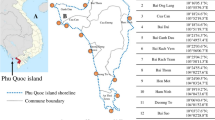Abstract
Chilika Lake, situated in the eastern part of India is a biodiversity site and is blessed with distinct assemblage of oceanic and fresh water. The lake having extremely rich fishery resources helps in generating instant employments and livelihoods to a large number of fishers and non-fishers residing in and around it. However, during the past few years the augmented utilisation of modern fishing technology including mechanised boats has increased the vulnerability of the traditional fisher folks. Based on a field survey of 450 fishing households (selected through multistage purposive sampling method), this paper highlights the changing concerns and crisis of traditional fishing livelihood in the context of overuse of motorised boats. In the past, the lake seems to have invited free entry and competition for fishing venture, and thereby promoting economic efficiency but resulting exactly the opposite effects. The study also reveals that the boat motorisation and its related new regulations resulting in climate vulnerability are fast weakening the traditional fisheries in the Chilika Lake. It is high time to regulate the present day means and ways of fishing in the lake keeping in mind the fast depletion of fishery resources and rapid degradation of lake environment. Thus, the article argues that the effective management of motorised boats, strict regulation of user’s rights to fishing and promotion of alternate non-fishing livelihood options can be a number of key factors for maintaining the lake’s rich biodiversity as well as sustaining fishery and aquaculture in the lake.
Similar content being viewed by others
References
Allison, E. H., & Ellis, F. (2001). The livelihoods approach and management of small-scale fisheries. Marine Policy, 25, 377–388.
Bailey, J. (1996). High seas fishing: Towards a sustainable regime. Sociologia Ruralis, 2, 189–200.
Baliarsingh, S. K., Sahoo, S., Acharya, A., Dalabehera, H. B., Sahu, K. C., & Lotliker A. A. (2014). Oil pollution in Chilika lagoon: An anthropogenic threat to biodiversity. Current Science, 104(4), 516–517.
Bhattacharya, H. (2002). Commercial exploitation of fisheries, production, marketing and finance strategies. New Delhi: Oxford University Press.
CDA. (2009). Socio-economic condition of fishers in and around Chilika. The project report for conservation and wise use of natural resources of the Chilika Lagoon through community participation in India (unpublished).
CDA. (2010). About Chilika: Climate. Available at http://www.chilika.com/climate.htm. Accessed on October 10, 2010.
CDA. (2011). Annual Report (2010–11), p. 8.
CMFRI. (1995). Marine fish landings in India during 1985–1993. Mar. Fish. Infor. Serv., T&E Series No. 136: January, February, March. Cochin, Fisheries Resources Assessment Division (FRAD).
Das, N. K., & Samal, R. C. (1998). Environmental survey of Chilika. In S. N. Patro (Ed.), Chilika, the pride of our wetland heritage (pp. 96–103). Bhubaneshwar: Orissa Environmental Society.
DOF. (1988). Handbook on fisheries statistics of Orissa, 1996/97. Bhubaneswar, Directorate of Fisheries, Government of Orissa.
Drammeh, O.K.L. (2007). Fisheries and aquaculture policy of Liberia. Draft final report. p. 36.
FAO. (1958). The state of food and agriculture. Rome: Food and Agriculture Orgnisation of the United Nations.
FAO. (1995). Code of conduct for responsible fisheries, Rome. www.fao.org/DOCREP/005/v9878e/v9878e00.htm.
FAO. (1998). FAO’s emergency activities: Technical handbook series. The emergency sequence: What FAO does—How FAO does it: Overview of the hand books. Rome. Available at http://www.fao.org/DOCREP/003/X6868E/X6868E00.HTM.
FAO. (2012). The state of world fisheries and aquaculture 2012. Rome: Food and Agriculture Organisation.
Nayak, P. K. (2014). The Chilika Lake social-ecological system: An historical analysis. Ecology and Society, 19(1), 1. doi:10.5751/ES-05978-190101.
Nedohin, D. N., & Elefsiniotis, P. (1997). The effects of motor boats on water quality in shallow lakes. Journal of Toxicological and Environmental Chemistry, 61, 127–133.
Pattanaik, Sarmistha. (2007). Conservation of environment and protection of marginalized fishing communities of Lake Chilika in Orissa, India. Journal of Human Ecology, 22(4), 291–302.
Rubinoff, Janet Ahner. (1999). Fishing for status: Impact of development on Goa’s fisherwomen. Women’s Studies International Forum, 22(6), 631–644.
Sahoo, S., Baliarsingh, S. K., Lotliker, A. A., & Sahu, K. C. (2014). Imprint of cyclone Phailin on water quality of Chilika lagoon. Current Science, 107(9), 1380–1381.
Satia, B., & Horemans, B. (1993). Report of the workshop on conflicts in costal fisheries in West Africa, IDAF/WP/53. Cotonou: Program for Integrated Development of Artisanal Fisheries in West Africa.
Sekhar, N. U. (2004). Fisheries in Chilika Lake: How community access and control impacts their management. Journal of Environmental Management, 73, 257–266.
Sutaria, D. (2007). Irrawaddy Dolphin—India. Whale and Dolphin Conservation Society. http://www.wdcs.org/submissions_bin/consprojectirr.pdf. Archived from the original on 25 Feb 2012.
Syafputri, E. (2014). Almost half of illegal Fishing in the world occur in Indonesia. https://en.tempo.co/read/news/2014/07/19/056594269/Almost-Half-of-Illegal-Fishing-in-the-World-Occur-in-Indonesia.
Vivekanandan, E. (2011). Marine fisheries policy brief 3—Climate change and Indian marine fisheries. CMFRI Special Publication, 105, 1–97.
Yousef, Y. A., McLellon, W. M., Gagan, R. H., Zebuth, H. H., & Larrabee, C. R. (1978). Mixing effects due to boating activities in shallow lakes. Tech Rep.ESEI No. 78-10, Washington DC, p. 199.
Author information
Authors and Affiliations
Corresponding author
Rights and permissions
About this article
Cite this article
Ray, S., Garada, R. Boat automation and fishery livelihood: a case of Chilika Lake in Odisha. Environ Dev Sustain 20, 2399–2414 (2018). https://doi.org/10.1007/s10668-017-9995-8
Received:
Accepted:
Published:
Issue Date:
DOI: https://doi.org/10.1007/s10668-017-9995-8




